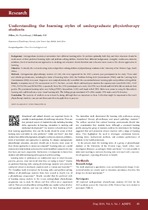| dc.contributor.author | Hess, Danelle | |
| dc.contributor.author | Frantz, Jose M. | |
| dc.date.accessioned | 2014-08-22T09:09:41Z | |
| dc.date.available | 2014-08-22T09:09:41Z | |
| dc.date.issued | 2014 | |
| dc.identifier.citation | Hess, D. & Frantz, J.M. (2014). Understanding the learning styles of undergraduate physiotherapy students. African Journal of Health Professions Education(AJHPE), 6(1):45-47 | en_US |
| dc.identifier.issn | 2078-5127 | |
| dc.identifier.uri | http://hdl.handle.net/10566/1199 | |
| dc.description.abstract | Background: Undergraduate students at universities have different learning styles. To perform optimally, both they and their educators should be made aware of their preferred learning styles and problem-solving abilities. Students have different backgrounds, strengths, weaknesses, interests, ambitions, levels of motivation and approaches to studying and educators should therefore aim to become more aware of the diverse approaches to learning. Objective: To identify the various learning styles and problem-solving abilities of physiotherapy students at the University of the Western Cape, South Africa. Methods: Undergraduate physiotherapy students (N=246) who were registered for the 2012 academic year participated in the study. Three valid
and reliable questionnaires, including the Index of Learning Styles (ILS), the Problem-Solving Style Questionnaire (PSSQ) and the Learning Style Questionnaire (LSQ), were used. Responses were analysed statistically to establish the association between learning styles and problem-solving ability. Results: A response rate of 72% was reported (n=177). For first-, second-, third- and fourth-year students the response rates were 65/85 (76%), 53/67 (79%), 31/58 (53%) and 28/36 (78%), respectively. Forty-five (25%) participants were male, 124 (70%) were female and 8 (0.04%) did not indicate their gender. The prominent learning styles were feeling (PSSQ), kinaesthetic (LSQ) and visual-verbal (ILS). Males were prone to using the kinaesthetic
learning style and females to a more visual learning style. The feeling group constituted 47% of the sample (39% males and 43% females). Conclusion. The majority of students seem to learn by doing, although facts are important to them. It therefore might be important to first teach physiotherapy students concepts and then assist them to apply these in practice. | en_US |
| dc.language.iso | en | en_US |
| dc.rights | © 2014 Hess & Frantz; licensee Health and Medical Publishing Group. This is an Open Access article distributed under the terms of the Creative Commons Attribution License (http://creativecommons.org/licenses/by/3.0), which permits unrestricted use, distribution, and reproduction in any medium, provided the original work is properly cited. | |
| dc.subject | Learning styles | en_US |
| dc.subject | Problem-solving abilities | en_US |
| dc.subject | Physiotherapy students | en_US |
| dc.subject | University of the Western Cape | en_US |
| dc.title | Understanding the learning styles of undergraduate physiotherapy students | en_US |
| dc.type | Article | en_US |
| dc.privacy.showsubmitter | false | |
| dc.status.ispeerreviewed | true | |

